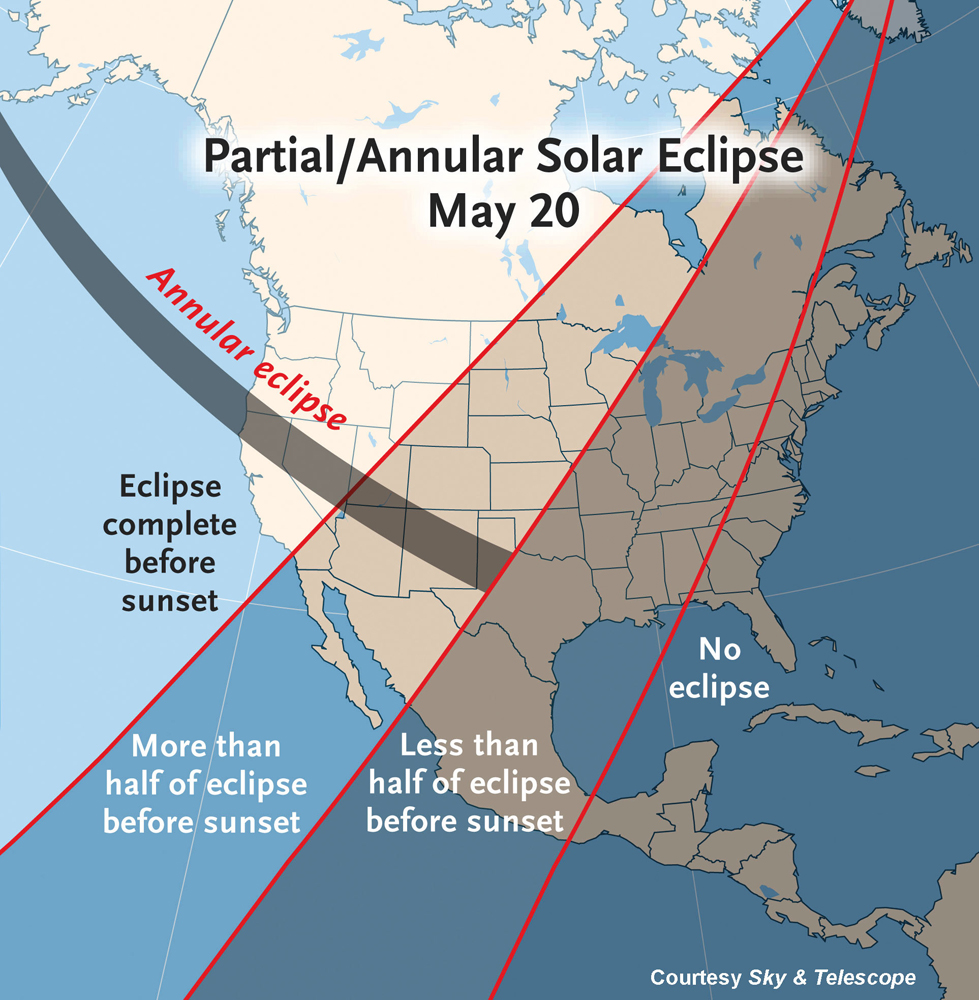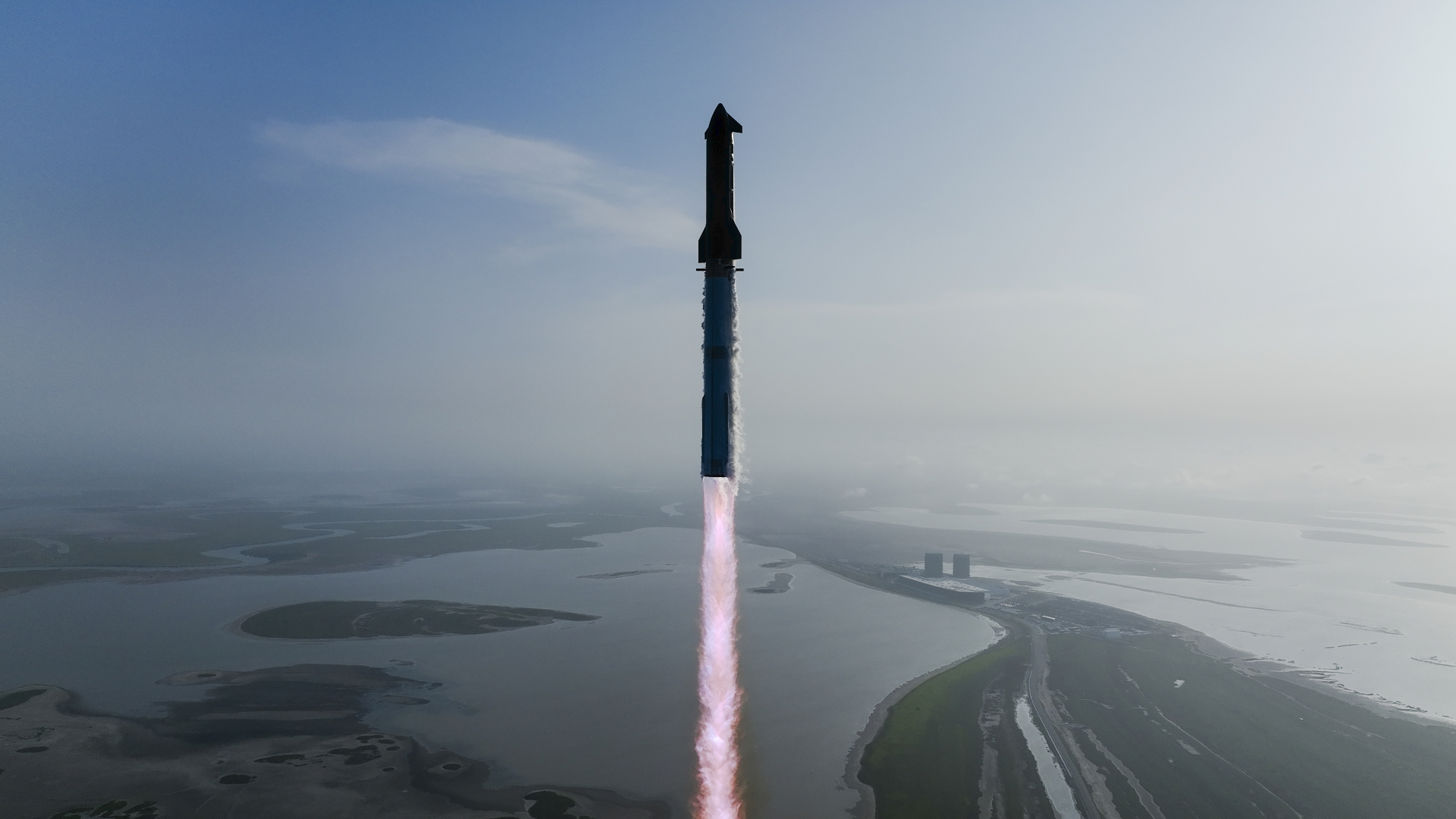
Almost all of North America will undergo a weird and dramatic event late Sunday afternoon (May 20). A partial eclipse of the sun will be visible, and for most, it will coincide with sunset.
Only for places northwest of a line running roughly from San Diego to Winnipeg will the eclipse be visible from start to finish before the sun sets. Elsewhere, depending on where you are, if your sky is clear toward the west-northwest, the setting sun will appear slightly dented, deeply crescent-shaped, or even ring-shaped.
The eclipse will begin in China, but in parts of eight western states — Oregon, California, Nevada, Colorado, Utah, Arizona, New Mexico and Texas — viewers living within a path averaging about 190 miles (306 kilometers) wide, will have a front-row seat to witness the rare and exciting spectacle of an annular solar eclipse, or ring eclipse. The path of annularity extends from the coastline at the California-Oregon border to northwestern Texas, where it will end at local sunset.
Places within the path include Medford, Ore.; Eureka, Calif.; Reno, Nev.; Albuquerque, N.M.; and Lubbock, Texas. Also within the path are two beloved national parks, Utah's Bryce Canyon and Arizona’s Grand Canyon. The U.S. National Park Service has invited the public to view the eclipse from a national partk this weekend. [May 20 Solar Eclipse: Complete Coverage]
But even if you're not positioned within the track of the ring phase, you shouldn’t get too envious, as the partial eclipse will definitely be a calendar marker most everywhere from the Pacific coast eastward.
Unfortunately for those living to the east of a line running approximately from Panama City, Fla., to Burlington, Vt., the sun will set before the eclipse begins, so those along the heavily populated Eastern Seaboard will miss out on seeing the solar show. But you will still be able to view the eclipse online via webcasts planned by the Slooh Space Camera website and others.
Solar eclipse first stop: China
Breaking space news, the latest updates on rocket launches, skywatching events and more!
Because the region of visibility straddles the international date line, this solar eclipse seems to begin on the day after it ends. The first people to see it will be those in eastern Asia who get up at sunrise on Monday morning, May 21.
The path of annularity begins in the Gulf of Tongking, to the north-northwest of Hainan Island, the smallest province of the People's Republic of China. The path will quickly move on to the northeast and encompass many densely populated cities such as Guangzhou and Taipei (China), Victoria (Hong Kong) as well as Osaka and Tokyo (Japan).
The moon will then throw its shadow across the Pacific Ocean, cross the date line and toward the latter part of the afternoon of May 20, onto much of North America. The moon will be only about 32 hours past the apogee of its orbit, so it will appear somewhat smaller than usual – smaller than the disk of the sun.
To be more precise, the moon’s circle will be only about 94.4 percent as wide as the sun; so 2.8 percent of the sun’s width will show on each side of the moon’s silhouette. Therefore, viewers in the shadow’s center will see not a total, but an annular eclipse: the sun will become a brilliant ring (or annulus) of light for up to several minutes encircling the moon’s dark silhouette.
That brilliant ring will average 1 arc-minute wide. This is as thin as a basketball hoop with a half-inch rim seen face-on from about 160 feet away.
Comprising 12 percent of the area of the solar disk, this ring will blot out the striking phenomena that would otherwise be seen at a total eclipse, such as the corona, prominences and the appearance of stars in a dark sky.

Sun's "ring of fire"
The ring will shine with only one-tenth of the sun’s normal total light, but this is less of a change than it sounds, since our eyes can adapt readily to changing light levels. [Video: Solar Eclipse of May 20 Explained]
It certainly will not become as dark as night; instead you might call it a weird “counterfeit twilight” as the quality of the light, may become unearthly. A clear sky should turn deep blue and the landscape oddly silvery. The temperature may take a perceptible drop; a cool breeze may begin to blow.
Venus, itself shining brightly, should become easily visible 23 degrees above and to the left of the sun — your clenched fist held at arm’s length measures about 10 degrees, so try looking for Venus a little more than two fists up and to the sun’s left near maximum eclipse. Block the sun with your hand to search for it.
The annular phase will last about 4 1/2 minutes if you are in the center of the eclipse path. Nearer the edge of the path, the duration will be shorter and the ring will look lopsided, with one side shining brighter than the other.
No doubt for a few hours on Sunday the eclipse almost certainly will top the news, followed of course by the usual dire warnings to the public not to risk blindness by carelessly looking at it. This has given most people the idea that solar eclipses are dangerous. Not so!
It’s the sun that’s dangerous – all the time! Ordinarily, we have no reason to gaze at it. A solar eclipse gives us a reason, but we shouldn’t stare at the sun without taking the proper safety precautions.
There are some safe ways to observe the sun. Special solar filters for telescopes and binoculars, as well as eclipse glasses and No. 14 welder's glass are some examples.
For a listing of local solar eclipse viewing circumstances for 52 cities in the United States, read this NASA chart by veteran solar eclipse expert Fred Espenak.
For a listing of local circumstances for cities in Canada, Mexico and Asia, Espenak has prepared this handy chart.
This information is given in Universal Time. The sun’s altitude and azimuth, the eclipse magnitude (fraction of the sun’s diameter occulted by the moon), and obscuration (fraction of the sun’s area occulted by the moon) are all given for the instant of maximum eclipse.
Editor's note: If you snap a great photo of Sunday's annular solar eclipse and would like it to be considered for use in a story or gallery, please send it to SPACE.com managing editor Tariq Malik at tmalik@space.com.
Joe Rao serves as an instructor and guest lecturer at New York's Hayden Planetarium. He writes about astronomy for The New York Times and other publications, and he is also an on-camera meteorologist for News 12 Westchester, New York.
Join our Space Forums to keep talking space on the latest missions, night sky and more! And if you have a news tip, correction or comment, let us know at: community@space.com.

Joe Rao is Space.com's skywatching columnist, as well as a veteran meteorologist and eclipse chaser who also serves as an instructor and guest lecturer at New York's Hayden Planetarium. He writes about astronomy for Natural History magazine, Sky & Telescope and other publications. Joe is an 8-time Emmy-nominated meteorologist who served the Putnam Valley region of New York for over 21 years. You can find him on Twitter and YouTube tracking lunar and solar eclipses, meteor showers and more. To find out Joe's latest project, visit him on Twitter.
